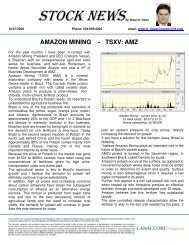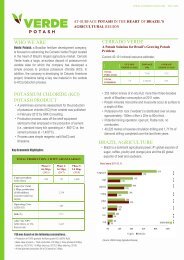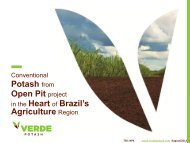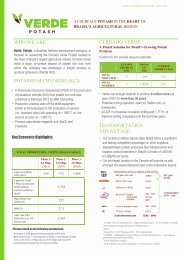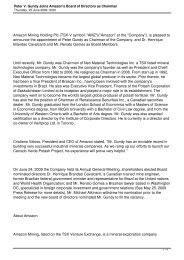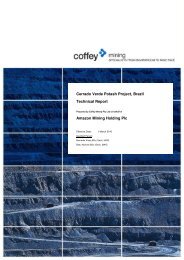NI 43-101 Preliminary Economic Assessment - Verde Potash
NI 43-101 Preliminary Economic Assessment - Verde Potash
NI 43-101 Preliminary Economic Assessment - Verde Potash
Create successful ePaper yourself
Turn your PDF publications into a flip-book with our unique Google optimized e-Paper software.
<strong>Verde</strong> <strong>Potash</strong> Plc 5-1<br />
Cerrado <strong>Verde</strong> Project<br />
<strong>NI</strong> <strong>43</strong>-<strong>101</strong> <strong>Preliminary</strong> <strong>Economic</strong> <strong>Assessment</strong><br />
5<br />
Geological Setting and Mineralization (Item 7)<br />
5.1 Regional Geology<br />
The region is mainly underlain by Neoproterozoic and Cretaceous rock units, which are partly<br />
covered by Cenozoic sandstones, lateritic sediments and soils. The oldest rocks, occurring in the<br />
southwestern portion of the region, are represented by a nucleus of calcoschists and diamictites<br />
of the Ibiá Formation (Araxá Group) surrounded by an undivided domain of the Canastra Group<br />
(quartzites, phyllites and micaschists). A model age of 1,000m.y. ( 207 Pb/ 206 Pb) has been<br />
determined for the Canastra Group, which was metamorphosed together with the Araxá Group<br />
during the Brasiliano Orogeny (600m.y.). The sequence is followed by the Bambuí Group (600-<br />
550m.y.), which comprises the marine deposits of the Paraopeba Formation, the Serra de Santa<br />
Helena Formation and the Serra da Saudade Formation, including the <strong>Verde</strong>te unit, all these units<br />
being dominated by variegated slates, and the overlying arkoses of the Três Marias Formation.<br />
Following the deposition of the Bambuí Group, and the Brasiliano Orogeny, the region was<br />
exposed to erosion during the Paleozoic, Triassic and Jurassic periods, giving rise to the<br />
development of a remarkable peneplane. In addition, the flat lying surface, the terrigenous<br />
sediments of the Areado Group was deposited during the Lower Cretaceous. The next<br />
stratigraphic phase is recorded by the extensive and dominantly piroclastic kamafugitic<br />
volcanism of the Mata da Corda Group of Upper Cretaceous age.<br />
5.2 Local and Project Geology<br />
5.2.1 The <strong>Verde</strong>te Unit<br />
The <strong>Verde</strong>te unit occurs mainly at the top of the Serra da Saudade Formation and underlies the<br />
Areado Group sandstone. The Serra da Saudade Formation consists of carbonate and siliciclastic<br />
sediments that were deposited in an epicontinental platform in the late Neoproterozoic (700 –<br />
600Ma). The <strong>Verde</strong>te occurs in extensive outcrops, along both banks of Indaiá River, in a trend<br />
approximately 120km x 20km. It covers the regions of municipalities of Santa Rosa da Serra,<br />
São Gotardo and Guarda dos Ferreiros (SW), Matutina, Quartel São João and Cedro do Abaeté<br />
(centre), Paineiras and Biquinhas (NE), in the State of Minas Gerais.<br />
The thickness of the <strong>Verde</strong>te unit varies from 15 to 80m in the southernmost domain to over 50m<br />
in the northern half of the Serra da Saudade range. The lower contact with the metasiltstone of<br />
the Serra da Saudade Formation is transitional within 2-3m.<br />
The Serra da Saudade Formation was eroded during the Gondwana Cycle (King, 1956) of<br />
probably Jurassic age, and it was over this extensive peneplain that the cretaceous sandstone<br />
beds of the Areado Group were deposited.<br />
The upper contact is transitional with rhythmic intercalations of <strong>Verde</strong>te and metasiltstone with<br />
various colors (predominantly pink when weathered), defined informally as the Transition Zone.<br />
These intercalations vary from millimeters to meters in thickness.<br />
The lower contact with the metasiltstone of the Serra da Saudade Formation is transitional within<br />
2 to 3m, and contains intercalations of limestone lenses and calciferous metasiltstone.<br />
5.2.2 Structure<br />
The <strong>Verde</strong>te unit and the Transition Zone underwent two main phases of folding. The first<br />
resulted in the development of pervasive concentric and chevron folds, in which the axial planes<br />
SRK Consulting (U.S.), Inc. September 16, 2011<br />
Cerrado <strong>Verde</strong>_<strong>NI</strong> <strong>43</strong>-<strong>101</strong> PEA_3<strong>43</strong>500.020_007_KG




